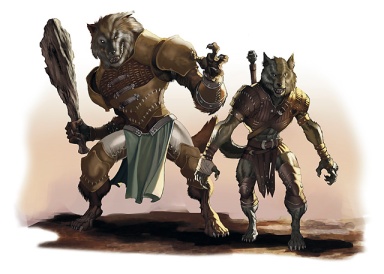I’ve always like primal classes, especially the druid — though I was more a fan of the druid that focused more on magic than wild shape.
However, as is usual when I overthink, it seemed strange awkward with primal spirits almost like deities to those classes.
And, up until Primal became its own power source in 4E, it was considered a branch of divine magic. This really makes sense in the grand scheme of the lore the classes and power source pulled from.
For instance, the druid class’s namesakes headed the ancient Celtic religion. Unfortunately, several factors — their secret oral traditions, the conquest by the Romans coupled with their anti-druid propaganda, the conversion to Irish Catholicism — left little behind of their actual practices.

- Unfortunately, it’s highly unlikely druids had this capability.
Also, some of the spirits mentioned specifically in 4E have distinct roots in Native American beliefs — like Fate Weaver, a.k.a. Grandmother Spider. Fate Weaver is a protector and a controller of fate. Compare that to Koyangwuti, of Spider Grandmother, from the Hopi legends — she created humanity from clay. A similar Navajo entity was considered a benefactor, though not creator.
Then there are the genius loci of Roman myths — essentially spirits that embody the wild places of the earth and originally consisting of the dryads, naiads and oreads that have been relegated to the Feywild.
But, while they were considered minor divinities, I think this is the route I’d rather go with my primal spirits. They aren’t worshiped, but they are revered as powerful beings by the primal peoples, which I will call natives for expediency’s sake. They may be benevolent to mortals, and some may be evil, but they are a part of the natural order to the natives who live in certain environments. Therefore, many natives often associate divine classes and deities with civilization and the rejection of the natural way mortals are meant to live — to them, gods are jsut powerful spirits that have been corrupted by power from worshipers.
Also, It doesn’t seem right to shoehorn a small number of entities into every tribe’s beliefs. So I’m going to focus on the concept of the genius loci. Not only does this feel more natural, but it will allow dungeon masters to use more material — have an adventure that uses Orc barbarians dedicated to Gruumsh, it shouldn’t take much to retool the standard D&D deity as an ancestral spirit or a voracious bestial entity
However, I will put together a short list of common entities tied to specific locations in Kalanesia. This will hopefully provide a bit more idea on the geography of this world.
THE MYSTERIUM JUNGLES

This expanse of jungle on a remote island south of the main continent was discovered only a year before the Bloodrift Warlock’s rise, and the rebuilding of the city states left the vast portion unexplored.
- Ta Yiki Gotra (The Silent Panther): This spirit is one associated with darkness, knowledge, stealth and secretes. It is often depicted as a black panther. His is the darkness among the trees, giving rise to superstition about keeping him at bay with central fires.
- Hangi Ban (The Laughing Ape): Associated with small, arboreal monkeys, Hangi Ban is mirthful and wild. His laughter can be heard among the trees, though legends warn travelers about not laughing with him — if you don’t share his mirth, his is likely to cause problems.
- Jua Jua Wae (The Providing Tree): The natives believe that the first jua jua tree (a tropical version of the redwoods of California that Kalanesian scientists have found, is harder than bronzewood, which is native to the main continent) was sentient and taught them how to use its dead wood to craft numerous tools.
- Nanat He (The Water Witch): It is because of this entity that natives distrust water that is not provided by jua jua, or that which is collected from natural rainfall. This woman lurks in the brackish rivers and shorelines waiting to drag unsuspecting travelers into the depths. Some believe she is actually a powerful sea hag.
THE SHALLOWS

Between the main continent and the Mysterium Jungles lies the Shallows, a series of small islands among an expansive coral reef.
- Palistro (The Great Cephalopod): Most reviled among the ocean spirits is this entity, which is blamed for all missing ships. It is associated with sudden storms and should sound familiar.
- Qualinona (The Endless School): This entity is a source of nourishment and represents, for the fishing natives, great bounty and fertility. Because of this, fishermen are hesitant to draw in more than two loads from a fruitful location for fear of upsetting Qualinona, and will sometimes return a fourth of the second haul to the school.
- Tialaso (The Wandering Turtle): This spirit represents travel and exploration, swimming the seas, ever searching. However, it also represents the return home to family — after all, sea turtles return to their birth places.
THE AMMN SANDS

The larger expanse of that houses the goblinoid city of Sher’Ammn, this desert hosts small, nomadic tribes that scratch a living.
- Shiqatam (The Lying Wanderer): Represented by the side-winding vipers that cross the desert, it represents deception and treachery by making travelers think the viper’s tracks lead somewhere. However, those who are fool often die in the wastes.
- Qa ’Tharaq (The Twisting Sands): This entity is a twisting sandstorm that whirls through the desert. The mystics of the tribes read the winds to determine its course. Though it represents destruction, it is also tied to ecstatic revelry and is invoked during ritualized celebration.
- Garum Ilaqui (The One Who Endures): Sometimes depicted as a dromedary camel or a white-cowled traveler who endlessly roams the desert. It is a spirit of perseverance and patience that has taught natives that these are the only ways to survive the harsh environment.
- Hara ib-Janwa (The Oasis Warden): Though pictured as female, this spirit is the guardian of oases. Under her protection, tribes see these lush locations as neutral ground — no fighting or the like is allowed. As such, they have become meeting grounds were grievances are settled.
THE HALIFARAN TUNDRA

Where the outpost city of Halifar rests against a natural harbor, the rest of the land extended in both barren and wooded tundra inhabited with close-knit tribal families.
- Baratok (The Wolf Mother): This wolf entity is considered a fierce protector and is tied to fertility. She guards the people of the tundra and teaches them cooperation and hunting skills. She is invoked in association with family rituals.
- Yovorkuk (The Vagrant Hunger): Depicted as an emaciated polar bear, this spirit is the rival to Baratok. He is single-minded in his pursuit of food. He serves as a warning to those members of the tribe who choose to shun the family.
- Nantuk Rocu (The Fruit Maiden): This spirit woman is has slowly been teaching the peoples of the Halifaran Tundra the art of agriculture and cultivation. Some extremists see her as too civilized compared to Baratok, but others revere her as another caretaker that is fit to aid the Wolf Mother.
THE RIVENWIND FOREST

Along the eastern edge of the main continent, a large deciduous forest claims the larger portion of the land, which is also home to Caer’ Salamë. Other than that one hub of civilization, the rest is the roaming ground of various natives.
- Goreitung (The Swiftrunner): Represented by a stag, this spirit is associated with swiftness, travel and cunning, eluding all the clever hunters of the forest. Because of his cleverness, the some natives refuse hunt deer, favoring boars and bear. Others, however, see it as the greatest accomplishment to slay such a beast.
- Arborant (The Willow Man): This spirit is associated with healing and medicine, since the tree’s bark produces a pain reliever. Unlike most primal spirits, it encourages science and the seeking of knowledge to better others. This makes it a disliked spirit among natives who see it as a threat to their lives of freedom from the confines of cities.
- Ygorang (The Vicious Wolf): Unlike Baratok, this spirit is cunning, is malicious and kills for the pleasure of it. It is considered the originator of rabies and their origin of the curse of lycanthropy.
THE SILVERBLADE SAVANNAH

Where the Amnn Sands begin to lessen, they turn into the Silverblade Savannah, named for its signature grass that is a tawny silver in color.
- Mgonawe Harab (The Lordly Lion): The king of beast and man, this entity is a just ruler who protects his dominion but switch smites those that seek to despoil the land and his subjects.
- Utu Kilamo (The Mad Elephant): While natives of the Silverblade will avoid elephants because of this spirit. While most elephants avoid people and only attack when provoked, this spirit actively seeks to destroy mortals. If you have ever heard of musth, this will make sense.
- Hrolam Ega (The Water Maiden): This is a dualistic spirit who requires sacrifice. She rules over the streams and lakes that sustain people and animals. But she is associated with crocodiles. In return for providing life-giving water, she demands payment in lives and blood for her pets. As such, natives sacrifice small animals to appease her on a monthly basis, but she is fickle and decides when the price is higher.
THE UNDERDARK

Just like the rest of the natural world, spirits have influenced the primitive peoples of the Underdark.
- Hhrokisgn (The Lurking Maw): This spirit is associated with the deep pools of the Underdark. It deals in stealth and hunger. Often seen as an aboleth, some argue that it isn’t a primal spirit at all, just a powerful aberration.
- Gamanta (The Golden Lord): This is a greedy spirit associated with all the valuable ores and gems that lie in the earth. He seeks retribution against those that attempt to take his wealth from the earth. As such, tribes of the Underdark are superstitious about accepting coinage in trade.
- Rozamir (The Cave Sculptor): This entity is said to roam the caverns carving the great art of the mineral formations that run through the Underdark. Some believe he first taught the dwarves their crafts and helped them ascend to their civilized state.
These genius loci primal spirits are the main objects of worship for orcs, goliath, shifters, gnolls and the elves. As I mentioned before, they have a belief system based around the sun and moon, which they believe are the rulers of the spirit world:
- Loresalin (The Lord of Sun and Life): This male personification of the sun rules over growth of all things and represents, as well, the progression of time and all that grows with it.
- Rewanessa (The Lady of Moon and Fate): This female personification of the moon reigns over death and the fates of the world. Just as she changes her face, she consoles those whose fates change.




















